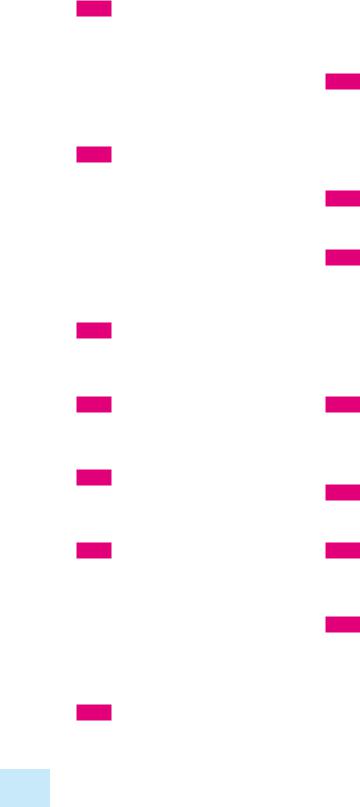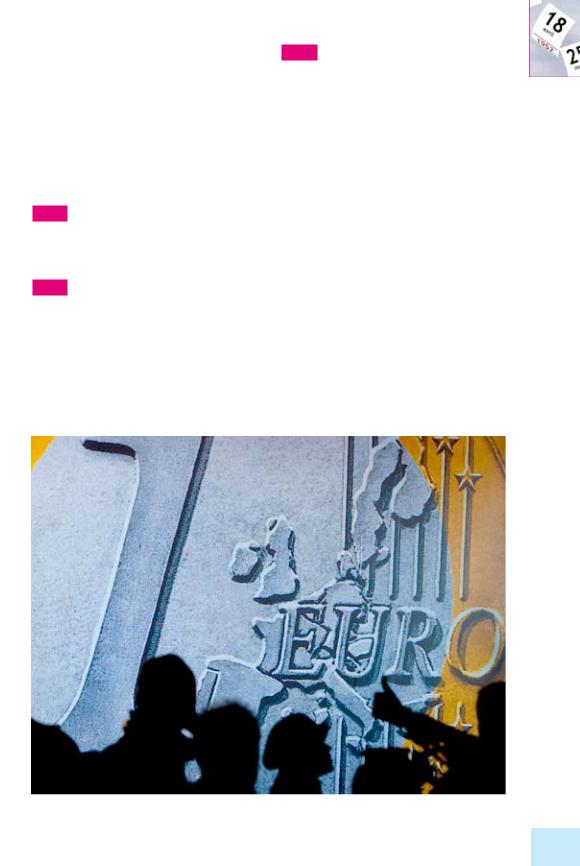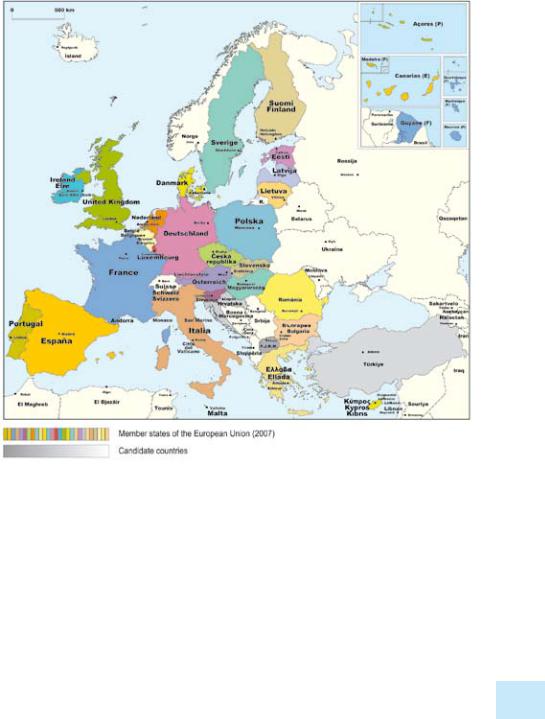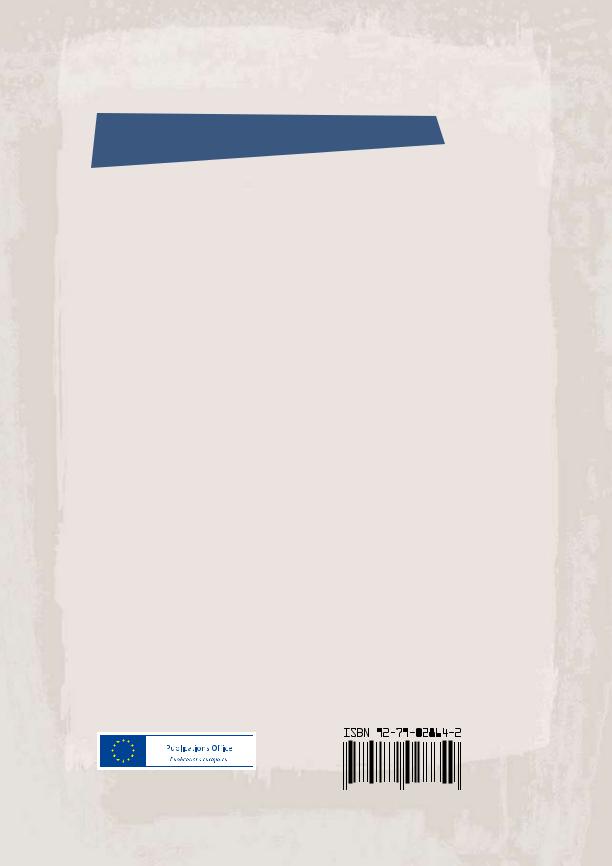
01_EU_overview
.pdf
1950
9 May
Robert Schuman, the French Minister of Foreign Affairs, makes an important speech putting forward proposals based on the ideas of Jean Monnet. He proposes that France and the Federal Republic of Germany pool their coal and steel resources in a new organisation which other European countries can join.
Since this date can be regarded as the date of birth of the European Union, 9 May is now celebrated annually as Europe Day.
1951
18 April
In Paris, six countries — Belgium, the Federal Republic of Germany, France, Italy, Luxembourg and the Netherlands — sign the Treaty establishing the European Coal and Steel Community (ECSC). It comes into force on 23 July 1952, for a period of 50 years.
1955
1–2 June
At a meeting in Messina, the foreign ministers of the six countries decide to extend European integration to the economy as a whole.
1957
25 March
In Rome, the six countries sign the treaties establishing the European Economic Community (EEC) and the European Atomic Energy Community (Euratom). They come into force on 1 January 1958.
1960
4 January
At the instigation of the United Kingdom, the Stockholm Convention establishes the European Free Trade Association (EFTA), comprising a number of European countries that are not part of the EEC.
1963
20 July
In Yaoundé, an association agreement is signed between the EEC and 18 African countries.
1965
8 April
A treaty is signed merging the executive bodies of the three Communities (the ECSC, EEC and Euratom) and creating a single Council and a single Commission. It comes into force on 1 July 1967.
1966
29 January
The ‘Luxembourg compromise’. Following a political crisis, France agrees to take part in Council meetings once again, in return for an agreement that the unanimity rule be maintained when ‘vital national interests’ are at stake.
1968
1 July
Customs duties between the member states on industrial goods are completely abolished, 18 months ahead of schedule, and a common external tariff is introduced.
1969
1–2 December
At the Hague Summit, the EEC’s political leaders decide to move further ahead with European integration, opening the way for its first enlargement.
1970
22 April
In Luxembourg, a treaty is signed allowing the European Communities to be increasingly financed from ‘own resources’ and giving greater supervisory powers to the European Parliament.
1972
22 January
In Brussels, treaties of accession to the European Communities are signed with Denmark, Ireland, Norway and the United Kingdom.
1973
1 January
Denmark, Ireland and the United Kingdom join the European Communities, bringing their membership to nine. Norway stays out, following a referendum in which a majority of people voted against membership.
Europe in 12 lessons
59

1974
9–10 December
At the Paris Summit, the political leaders of the nine member states decide to meet three times a year as the European Council. They also give the go-ahead for direct elections to the European Parliament, and agree to set up the European Regional Development Fund.
1975
28 February
In Lomé, a convention (Lomé I) is signed between the EEC and 46 African, Caribbean and Pacific (ACP) countries.
22 July
A treaty is signed giving the European Parliament greater power over the budget and establishing the European Court of Auditors. It comes into force on 1 June 1977.
1979
7–10 June
The first direct elections to the 410-seat European Parliament.
1981
1 January
Greece joins the European Communities, bringing the number of members to 10.
1984
14–17 June
The second direct elections to the European Parliament.
1985
7 January
Jacques Delors becomes President of the Commission (1985–95).
14 June
The Schengen Agreement is signed with the aim of abolishing checks at the borders between member countries of the European Communities.
1986
1 January
Spain and Portugal join the European Communities, bringing their membership to 12.
17 and 28 February
The Single European Act is signed in Luxembourg and The Hague. It comes into force on 1 July 1987.
1989
15 and 18 June
The third direct elections to the European Parliament.
9 November
The fall of the Berlin Wall.
1990
3 October
German unification.
1991
9–10 December
The Maastricht European Council adopts a Treaty on European Union, laying the foundation for a common foreign and security policy, closer cooperation on justice and home affairs and the creation of an economic and monetary union, including a single currency.
1992
7 February
The Treaty on European Union is signed at Maastricht. It comes into force on 1 November 1993.
1993
1 January
The single market is created.
1994
9 and 12 June
The fourth direct elections to the European Parliament.
1995
1 January
Austria, Finland and Sweden join the EU, bringing its membership to 15. Norway stays out again following a referendum in which a majority of people voted against membership.
60

23 January
A new European Commission takes office with Jacques Santer as its President (1995–99).
27–28 November
The Euro-Mediterranean Conference in Barcelona launches a partnership between the EU and the countries on the southern shore of the Mediterranean.
1997
2 October
The Amsterdam Treaty is signed. It comes into force on 1 May 1999.
1998
30 March
The accession process begins for the new candidate countries. Cyprus, Malta and 10 central and eastern European countries will be involved in this process.
1999
1 January
Start of the third stage of EMU: 11 EU countries adopt the euro, which is launched on the financial markets, replacing their currencies for non-cash transactions. The European Central Bank takes on responsibility for monetary policy. The 11 countries are joined by Greece in 2001.
10 and 13 June
The fifth direct elections to the European Parliament.
15 September
A new European Commission takes office with Romano Prodi as its President (1999– 2004).
15–16 October
The Tampere European Council decides to make the EU an area of freedom, security and justice.
Europe in 12 lessons
© Reuters
A new currency was born in 1999, when the euro was introduced for financial (non-cash) transactions. Notes and coins followed in 2002.
61

2000
23–24 March
The Lisbon European Council draws up a new strategy for boosting employment in the EU, modernising the economy and strengthening social cohesion in a knowledge-based Europe.
7–8 December
In Nice, the European Council reaches agreement on the text of a new Treaty changing the EU’s decision-making system so that the Union will be ready for enlargement. The presidents of the European Parliament, the European Council and the European Commission solemnly proclaim the Charter of Fundamental Rights of the European Union.
2001
26 February
Signing of the Treaty of Nice. It comes into force on 1 February 2003.
14–15 December
Laeken European Council. A declaration on the future of the EU is agreed. This opens the way for the forthcoming major reform of the EU and for the creation of a Convention to draft a European Constitution.
2002
1 January
Euro notes and coins are introduced in the 12 euro-area countries.
13 December
The Copenhagen European Council agrees that 10 of the candidate countries (Cyprus, the Czech Republic, Estonia, Hungary, Latvia, Lithuania, Malta, Poland, Slovakia and Slovenia) can join the EU on 1 May 2004.
2003
10 July
The Convention on the Future of Europe completes its work on the draft European Constitution.
4 October
Start of the intergovernmental conference responsible for drawing up the constitutional treaty.
2004
1 May
Cyprus, the Czech Republic, Estonia, Hungary, Latvia, Lithuania, Malta, Poland, Slovakia and Slovenia join the European Union.
10 and 13 June
The sixth direct elections to the European Parliament.
29 October
The European Constitution is adopted in Rome (subject to ratification by member states).
22 November
A new European Commission takes office with José Manuel Barroso as its President.
2005
29 May and 1 June
Voters in France reject the Constitution in a referendum, followed three days later by voters in the Netherlands.
3 October
Accession negotiations begin with Turkey and Croatia.
2007
1 January
Bulgaria and Romania join the European Union.
Slovenia adopts the euro.
62

The European Union
63
European Commission
Europe in 12 lessons by Pascal Fontaine
Luxembourg: Office for Official Publications of the European Communities 2006 — 62 pp. — 16.2 x 22.9 cm
ISBN 92-79-02864-2
What purpose does the EU serve? Why and how was it set up? How does it work? What has it already achieved for its citizens, and what new challenges does it face today? How can citizens get more involved?
In an age of globalisation, can the EU compete successfully with other major economies and maintain its social standards? Can Europe continue to play a leading role on the world stage and help protect against terrorism?
These are just some of the questions Pascal Fontaine — EU expert and former university lecturer — explores in the new 2007 edition of his popular booklet ‘Europe in 12 lessons’.

Other information about the European Union
Go online
Information in all the official languages of the European Union is available on the Europa website: europa.eu
Visit us
All over Europe there are hundreds of local EU information centres. You can find the address of the centre nearest you on this website: europedirect.europa.eu
 Call or write to us
Call or write to us
 EUROPE DIRECT is a service which answers your questions about the European Union. You can contact this service by freephone: 00 800 6 7 8 9 10 11
EUROPE DIRECT is a service which answers your questions about the European Union. You can contact this service by freephone: 00 800 6 7 8 9 10 11
(or by payphone from outside the EU: (32-2) 299 96 96), or by electronic mail via europedirect.europa.eu
You can also obtain information and booklets in English about the European Union from:
EUROPEAN COMMISSION REPRESENTATIONS |
222 East 41st Street, 20th floor |
Representation in Ireland |
New York, NY 10017 |
18 Dawson Street, Dublin 2 |
Tel. (212) 371 38 04 |
Tel. (353-1) 634 11 11 |
Fax (212) 688 10 13 |
Fax (353-1) 634 11 12 |
Internet: www.eurunion.org |
Internet: www.euireland.ie |
|
E-mail: eu-ie-info-request@ec.europa.eu |
EUROPEAN PARLIAMENT OFFICES |
|
Office in Ireland |
Representation in the United Kingdom |
European Union House |
8 Storey’s Gate, London SW1P 3AT |
43 Molesworth Street, Dublin 2 |
Tel. (44-20) 79 73 19 92 |
Tel. (353-1) 605 79 00 |
Fax (44-20) 79 73 19 00/10 |
Fax (353-1) 605 79 99 |
Internet: www.ec.europa.eu/uk |
Internet: www.europarl.ie |
|
E-mail: epdublin@europarl.europa.eu |
Representation in Wales |
|
2 Caspian Point, Caspian Way, |
United Kingdom Office |
Cardiff CF10 4QQ |
2, Queen Anne’s Gate, London SW1H 9AA |
Tel. (44-29) 20 89 50 20 |
Tel. (44-20) 72 27 43 00 |
Fax (44-29) 20 89 50 35 |
Fax (44-20) 72 27 43 02 |
Internet: www.ec.europa.eu/uk |
Internet: www.europarl.org.uk |
|
E-mail: eplondon@europarl.europa.eu |
Representation in Scotland |
|
9 Alva Street, Edinburgh EH2 4PH |
Office in Scotland |
Tel. (44-131) 225 20 58 |
The Tun, 4 Jackson’s Entry, |
Fax (44-131) 226 41 05 |
Holyrood Road, Edinburgh EH8 8PJ |
Internet: www.ec.europa.eu/uk |
Tel. (44-131) 557 78 66 |
|
Fax (44-131) 557 49 77 |
Representation in Northern Ireland |
Internet: www.europarl.org.uk |
Windsor House |
E-mail: epedinburgh@europarl.europa.eu |
9/15 Bedford Street, Belfast BT2 7EG |
|
Tel. (44-28) 90 24 07 08 |
There are European Commission and Parliament |
Fax (44-28) 90 24 82 41 |
representations and offices in all the countries of |
Internet: www.ec.europa.eu/uk |
the European Union. The European Commission |
|
also has delegations in other parts of the world. |
Information services in the United States |
|
2300 M Street, NW — 3rd floor |
|
Washington DC 20037 |
|
Tel. (202) 862 95 00 |
|
Fax (202) 429 17 66 |
|
Internet: www.eurunion.org |
|

Europe in 12 lessons
What purpose does the EU serve? Why and how was it set up? How does it work? What has it already achieved for its citizens, and what new challenges does it face today? How can citizens get more involved?
In an age of globalisation, can the EU compete successfully with other major economies and maintain its social standards? Can Europe continue to play a leading role on the world stage and help protect against terrorism?
These are just some of the questions Pascal Fontaine — EU expert and former university lecturer — explores in the new 2007 edition of his popular booklet ‘Europe in 12 lessons’.
9 789279 028649 >
NA-AK-06-290-EN-C
